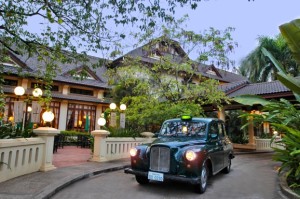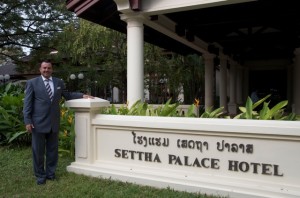Precious Friend!
Landed in Vientiane after an hour’s flight from Bangkok. In grand style, The Settha Palace Hotel’s vintage limousine met and transported me through Laos’ tranquil capital. What a pleasure is Vientiane! Its manageable street chaos is a rarity amid other Southeast Asian capitals.
Passed the Laotian twin of France’s Arc de Triompheen route to the Settha Palace Hotel that resides in the very heart of Vientiane. Without you here, it was a good place for my heart to visit. Monumental in spirit while human in scale, Patuxai is dubbed “the vertical runway.” Apparently, some American concrete sent to complete an important airport was somehow diverted. And yes, that very same cement was used to complete Patuxai. “Patu” is ‘door’ in Sanskrit; “xai” is ‘victory.’ Thus is Laos’ victory monument to honor resisting colonialism showcased to voyagers.
I entered the Settha Palace Hotel and sensed at once that something special awaited. Its gracious 1930s décor and quiet elegance formed the backdrop as Director of Sales Sisouk greeted me warmly. This hotel is unique, I thought. Subsequently, when General Manager Luquer sent a generous welcome basket to my room, I realized how much this action continued decades of The Settha Palace’s gracious reputation.
From the 1932 opening straight through the four decades hence, The Settha Palace was Vientiane’s chic colonial enclave. When the Pathet Lao seized power and overthrew the monarchy in 1975, capital flight ensued. Yet The Settha Palace Hotel, an obvious capitalist icon, remained ripe to vilify. The hotel became government housing for 30 families plus their livestock. The latter, of course, accelerated the hotel’s decay and systemic decline.
Now fast-forward to the invitation extended to French/Lao hotelier Billy Theodas and his Mother to return to the Settha Palace in 1994, at the behest of the Lao People’s Democratic Republic. Theodas was inspired to retrofit his family’s hotel where he spent his formative years. The significant destruction they witnessed catalyzed them into action. He dedicated many years to navigate through the bureaucratic challenges as he restored The Settha Palace to its former colonial grandeur. Today, Belmont International Hotels, his Singapore-based firm, operates The Settha Palace Hotel. This colonial masterpiece resides again in Vientiane.
Its stunning 29 rooms and suites meticulously showcase the French-colonial style: period sconces and brass chandeliers, the dramatic expansive sweep of the polished rosewood staircase, the sleek marble lobby and rosewood furnishings – all recall a quieter moment in the world. There was as much intrigue then, yet much less intensity as now. Outside, beside its lush garden and navy-tiled pool, the Settha Palace is where hospitality reigns.
The rooms and suites feature rosewood furnishing, four-poster beds and the coup de foudre: the thunderbolt of 1930s black and white tiled bathrooms with XXIst century luxuries. The hotel’s La Belle Epoque, one of Vientiane’s most respected French restaurants, offers creative French dishes with just a taste, the literal soupçon, of French Indochine flair.
I left the Settha Palace to visit Wat Sisaket, Vientiane’s only working monastery, a beautifully preserved and functional site where iconic Buddha statues reside, and chanting resounds frequently. Across the street stands Wat Ho Phra Keo, once the home of the famed Emerald Buddha. The name, in fact, means the “Altar of the Emerald Buddha” which immortalizes the altar that remains today, as the stature of the Emerald Buddha resides in Bangkok.) Arguably, this temple is a jewel in the Vientiane monastery crown.
Laos’ national symbol is Pha That Luang, a massive gold-leafed stupa. Dear,stupas house religious relics. Just beside it is the King’s statue, and a remarkable fact is that the Communists never destroyed this statute. It remains Laos’ national icon.
A short drive outside Vientiane is an extraordinary garden that features a massive, though recent, collection of some 200 Hindu and Buddhist deity sculptures, all designed and built by a former monk. What amazing energy emanates here! You and I will certainly return for a colonial experience at The Settha Palace. Let’s plan that soon, mon Chou!
Travel agents receive net pricing.
Settha Palace Hotel, www.setthapalace.com


